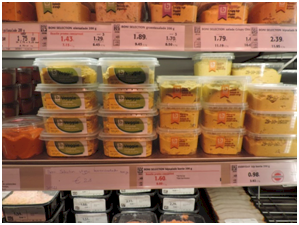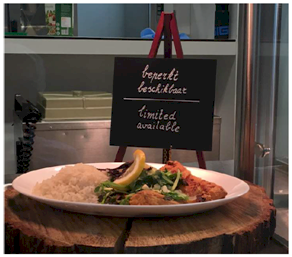By Kristof Rubens
Good intentions
Flemish citizens are generally concerned about the state of the environment and want to reduce any negative impact they may have on the environment. Despite good intentions, however, this attitude does not automatically translate into environmentally friendly choices (the so-called intention-behavior gap). These choices include eating less meat, substituting meat with vegetarian alternatives, consuming more seasonal fruit and vegetables, etc. When it comes to food purchases, consumers are guided by convenience, habit, and speed, and influenced by emotions, such as their mood, or even the weather. Information and campaigns designed to guide people’s choices often do not produce the desired results, because the process of purchasing food is largely an unconscious one.
Behavioral economics
Behavioral science suggests that consumers can be guided to make environmentally friendly choices without communicating explicitly about sustainability. A gentle push, a nudge, in the right direction can help. These interventions are non-intrusive and do not limit consumers’ freedom of choice. To investigate the potential benefits of applied behavioral insights, the Flemish government’s Environmental, Nature and Energy Department conducted tests in several locations (Colruyt supermarkets, student canteen at Ghent University and the company canteen of KBC, a financial services company) during a period of one month. The studies were conducted by the Marketing Department at Ghent University and the Dijksterhuis & van Baaren consultancy.
Lowering meat consumption and increasing seasonal produce purchases
In total three behavioral interventions on three different product groups were tested at Colruyt supermarkets.
In the first intervention, smaller portion sizes of sausages were added to the existing sausage selection. Thanks to this added choice and a smart in-store positioning, there was a clear purchasing shift toward these smaller portions. In total, we saw a decrease of 20% in the average weight of purchased sausages. Consumers did not compensate for this by increasing their purchase of other meat products.
A second intervention sought to stimulate the sale of vegetarian spreads by displaying them next to the meat version and targeting flexitarian consumers – people with a reduced meat diet. Before the intervention, both products were sold in different locations within the store. This nudge resulted in the doubling of the share of vegetarian spreads sold compared to their counterpart.

Curry spread: The vegetarian option (left) next to the meat option (right)
Finally, we designed an intervention to increase the sales volume of seasonal fruit and vegetables. In this test, produce were presented on a central display. We combined this smart positioning with a point-of-sale display that read ‘Fruit and vegetables in season’. The intervention resulted in a sales increase of 20% to 30% in the category. In addition, a ‘This tastes good in puree’ message led to a rise in sales of celeriac (which was in season) by 25%.
Environmentally friendly food choices in canteens
We also successfully introduced small nudges in canteens for KBC staff canteen and students at Ghent University. Some of our interventions were designed to break habitual behavior by inducing a mindset that encourages consumers to try new things. Along the route leading to the canteens, pictures with slogans containing words like ‘new’, ‘together’ and ‘taste’ were displayed. The addition of a descriptive adjective to menu items, such as ‘traditional’ or ‘authentic’, also aimed to make the target items more desirable. Other nudges applied the scarcity principle by adding a sign which stated ‘Limited available’ (see picture below). Finally, we increased the visual attractiveness of the ‘best choice’ by adding natural elements (a wooden plate) and ingredients (an olive oil flask and some peppers). On average, our interventions resulted in a sales uplift of environmentally friendly choices by an average of five percentage points.

The scarcity effect at Ghent University’s student restaurant
Our research has shown that Flemish people are ready to consume more environmentally sustainable foods. A gentle ‘nudge in the green direction’ can help to achieve behavior that is consistent with those attitudes. As a result, society as a whole can achieve significant environmental gains. However, our one-month study allowed us to investigate only the short-term results of interventions. The practice of nudging raises an important question about the endurance of behavior change. Once positive results are achieved, do they continue? Or do they subside over time? We are about to start a follow-on project that will try to find an answer to this question.
Detailed reports about our research projects can be found here : https://www.lne.be/milieuverantwoorde-consumptie-studies-in-vlaanderen (“Een duwtje in de groene richting” Dutch versions only).


